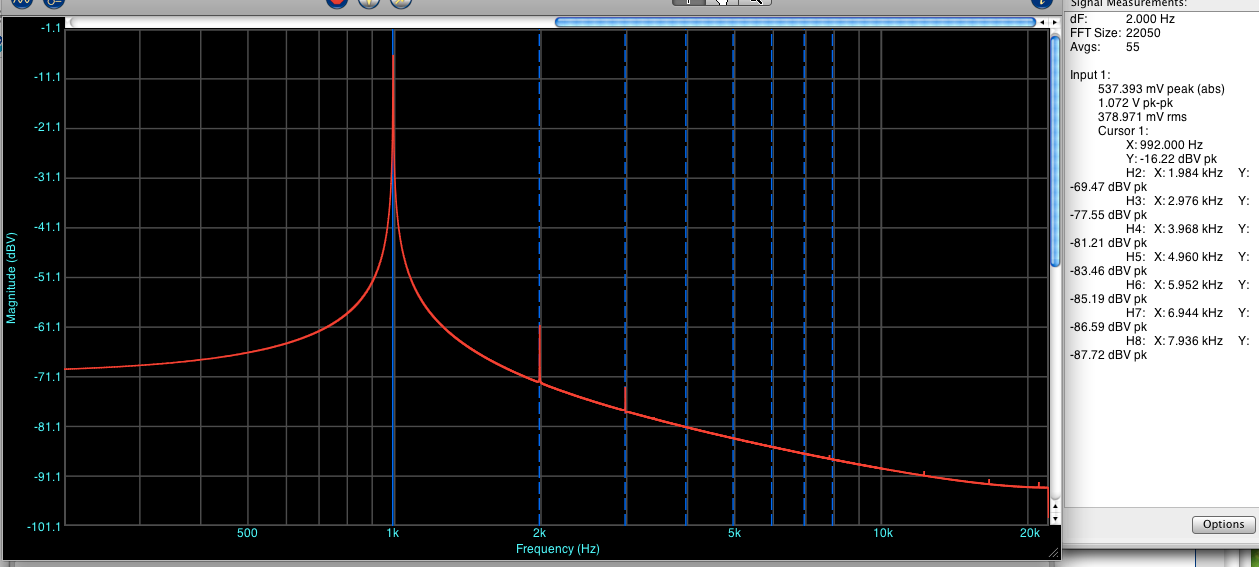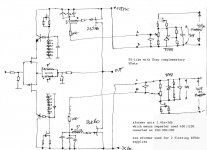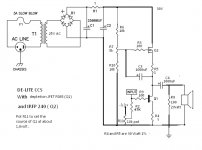He has about a dozen R100s not that well matched
fuggedaboutit.
Beauty of F6. Matching not necessary, just convenient. if you can get two matched pairs, you are great and full of possiblity.
I bought two pairs from Teabag last year. Was the end of the lot. So-so match, but better than nothing. I hope I don't fry one. And I can only build one amp.
From now on I'm stocking up on stuff if it's gonna be discontinued. Especially if it's in a Pass design.
But basically not many will get to build an F6.
Who said i did. In my preferred version, I have a degeneration resistor on the top fet. Is this not an example of an f6 with degeneration.
Perhaps I misunderstood what you were saying.
Yes, the circuit you show has AC degeneration, since the transformer winding connects to the bottom of the source resistor. However by connecting the transformer to top of the source resistor there is no AC degeneration, but you still have the advantage of DC bias stability, even with ordinary MOSFETs.
Last edited:
Perhaps I misunderstood what you were saying.
Yes, the circuit you show has AC degeneration, since the transformer winding connects to the bottom of the source resistor. However by connecting the transformer to top of the source resistor there is no AC degeneration, but you still have the advantage of DC bias stability, even with ordinary MOSFETs.
Your are absolutely correct. IMuneducatedO, it is the lack of Rs that is part of the sig of the sound that I like. That being said, i have only tried the SS and have no idea of its affects on IRF setup. I havea said before that I liked the 2sk1058 lateral version i tried, as it allowed similar situtaion to SS. My thought is that either pair of lateral outputs or single Cree will best IRF in performance. I also haev to try Choky's 2sk82 version.
@vdienna,
R085 can be used with slightly more complexity. it will woprk inbelow schematic
Attachments
Last year, a DIYer suggested using an adjustable positive voltage regulator [LM317] in lieu of a depletion-style N-JFET. Its Adjust port [akin to Gate] is ~1.25V lower in magnitude than that of its Output port [like the source]. May try Zen Mod's schematic first with the cheap and available LM317 to undestand its operation. I'll find the original post. Back then, R100A was flying high, and this idea [LM317] was shelved.Your are absolutely correct. IMuneducatedO, it is the lack of Rs that is part of the sig of the sound that I like. That being said, i have only tried the SS and have no idea of its affects on IRF setup. I havea said before that I liked the 2sk1058 lateral version i tried, as it allowed similar situtaion to SS. My thought is that either pair of lateral outputs or single Cree will best IRF in performance. I also haev to try Choky's 2sk82 version.
@vdienna,
R085 can be used with slightly more complexity. it will woprk inbelow schematic
Thanks Antoinel. I have these schematics, but it's not quite the F6.
I agree, diyF6 is made of 3 unique parts, and thus a signature performance.
- A front end of the familiar SK/SJ Fets
- A cetrain Jensen Transformer
- R100As output Fets
Read the transcript of the F6 talk on 6moons. It seems that the exercise was more about making a push-pull amp when all you want to use is N-channel devices and have a couple of quadfilar transformers laying around.
Yes, it uses a K170/J74 front-end. As Papa reportedly has a couple of 55-gallon drums full of them sitting in various places around Pass Labs, and that they are basically perfect for a complementary input stage, so they have been used.
It's my opinion that there is nothing particularly special about the Jensen transformer. (This in no way detracts from it's very high quality...) It's a very well-made quadfilar 1:1 transformer made for signal sizes found in home and Pro audio. You can find similar items from various manufacturers. Look at Tea-Bag's blog entry on the F6 and look at the FFT plots... After seeing those I decided on not choosing the Jensen...
As to the requirement of the R100A power Jfet;
Yes, there is no doubt (as mentioned in my first sentence) that the exercise was because there in no P-channel complement to the R100A. But my (very limited) experience has shown me that 1) The transformer is going to be the Belle of the ball in this equation, and 2) with the variable distortion character as provided by the output degeneration potentiometers, you will be able to make this sound however you want, regardless of the output device.
"But Jim, I don't have a distortion analyzer! How can I measure and set the pots?"
That is painfully simple, once the secret is let out. (Thank you Generg and Tea-Bag)
Make one of these - Electronic Equiptment - DIY soundcard scope probe
Connect it across a 4- or 8-ohm resistor on the output of your amp. Feed your amp a nice 1KHz sinewave. Adjust the pot so that you send no more than a 1V signal to the computer input.
Plug into your computer mic input and use a FFT program like this audioTester or this SignalScope
You will have resolution that was only dreamed about 30yr ago, and can adjust the distortion visually, looking at the 2nd and 3rd harmonic peaks on the FFT plot.

Taken from another thread about bias vs. distortion, but cleanly shows the fundamental at 1K, and the harmonic peaks at 2 and 3K.
As Papa says;

Yes, it uses a K170/J74 front-end. As Papa reportedly has a couple of 55-gallon drums full of them sitting in various places around Pass Labs, and that they are basically perfect for a complementary input stage, so they have been used.
It's my opinion that there is nothing particularly special about the Jensen transformer. (This in no way detracts from it's very high quality...) It's a very well-made quadfilar 1:1 transformer made for signal sizes found in home and Pro audio. You can find similar items from various manufacturers. Look at Tea-Bag's blog entry on the F6 and look at the FFT plots... After seeing those I decided on not choosing the Jensen...
As to the requirement of the R100A power Jfet;
Yes, there is no doubt (as mentioned in my first sentence) that the exercise was because there in no P-channel complement to the R100A. But my (very limited) experience has shown me that 1) The transformer is going to be the Belle of the ball in this equation, and 2) with the variable distortion character as provided by the output degeneration potentiometers, you will be able to make this sound however you want, regardless of the output device.
"But Jim, I don't have a distortion analyzer! How can I measure and set the pots?"
That is painfully simple, once the secret is let out. (Thank you Generg and Tea-Bag)
Make one of these - Electronic Equiptment - DIY soundcard scope probe
Connect it across a 4- or 8-ohm resistor on the output of your amp. Feed your amp a nice 1KHz sinewave. Adjust the pot so that you send no more than a 1V signal to the computer input.
Plug into your computer mic input and use a FFT program like this audioTester or this SignalScope
You will have resolution that was only dreamed about 30yr ago, and can adjust the distortion visually, looking at the 2nd and 3rd harmonic peaks on the FFT plot.

Taken from another thread about bias vs. distortion, but cleanly shows the fundamental at 1K, and the harmonic peaks at 2 and 3K.
As Papa says;
Last edited:
Thank you 6L6 for your in depth and valuable analysis. Mr Pass called the parent of F6 a Classic. Others like him [you included], believe that its topology is versatile; because it will readily embody many valuable variations. Still, F6 as a name [and its base components] are the sole property of FirstWatt. Only Mr. Pass can upddate it. He may even name the winner modified amp F7!
Has diyF6 changed the "audio lives" of generg, flocchini. buzzforb, lhquam, Zen Mod, etc..? A testimonial blurb by said DIYers will be beneficial to the rest of us as it'll enlighten and further add to the analysis of 6moons.
Has diyF6 changed the "audio lives" of generg, flocchini. buzzforb, lhquam, Zen Mod, etc..? A testimonial blurb by said DIYers will be beneficial to the rest of us as it'll enlighten and further add to the analysis of 6moons.
how's that ?
you measured origigi M2 - is it K3 or K2 dominant ?
pardone moi , I forgot ...... in case that you already wrote that .....
Je vous pardonnez mon Chou Chou, j'ai vous déjà envoyez le spectre!
I do not want to publish it here, but as Papa said himself, in his owner manual, the M2 is clearly k3 dominant at 1kHz/1W.
But Nelson managed to let him sound very tubelike, dark, pleasant.
From the sound you could bet it is k2 dominant!
But when I wrote this some time ago, he answered, as far as I understood, to look not only at the distortion spectra at 1kHz, but over the whole range.
Means I have to get acquainted to ARTA Steps, there you can trace the distortion of k2 and k3 over the complete frequency range.
My Windows 32 bit was to slow, it recognized only 3Gbyte of my 6GByte DRam.
Now I changed to Windows 64bit and ARTA runs stable now.
So I can start with STEPS soon.
I suppose the xformer makes his own k2/3 distribution at the values higher or lower than 1kHz.
- Home
- Amplifiers
- Pass Labs
- F6 Amplifier



